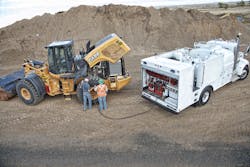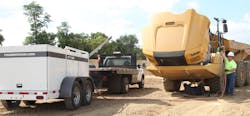Clean Practices Prevent Lube Contamination
Mike Twedt is extremely conscious of the lubrication products and procedures his field technicians use. Twedt is the eastern region equipment manager for Minnesota Limited, an infrastructure construction firm that builds pipelines, and he says projects are usually under the scrutiny of environmental agencies. He manages about 1,500 pieces of equipment.
Contamination control is a double-ended job that focuses on keeping contaminants out of the lubricants, as well as keeping used lube products out of the job site, he says. With the advantage of military training, Twedt is meticulous and provides his mechanics and technicians strong leadership.
“They all have a solid understanding of the environmental concerns the company’s customers demand and put extra effort into making sure they work clean,” Twedt says.
For example, potential spills are headed off with the use of high-pressure quick couplers for hydraulic fluids. Twedt also takes into consideration where his fleet’s equipment will work and where it might later be transported.
“The areas we work in are mountainous, which makes the engine work harder, so maintaining fluid pressure is important,” he says. “We rely on fluid sampling to monitor our oil performance.” Twedt says less oil is required on flat land jobs, but more is needed on mountain work, so simply routinely topping off fluids doesn’t address the demands of the working environment.
When it comes time to transport a vehicle from a steep angled hill, Twedt will instruct his techs to add a bit more oil before the machine is winched and loaded. He does this to ensure there is enough oil in it to function properly in case some of the fluid drained to one side while it was parked at a 45-degree angle on the mountainside.
Twedt credits the company’s proactive leadership, OEM support, and ongoing training for his crews’ buy-in with the lube program. “We gather the foremen, superintendents, and master mechanics each year to go over important things that have happened during the year. We change what needs to be changed and acknowledge achievement.”
Mobile lube equipment
In addition, innovation in field-service equipment is making field lube service and fluid-maintenance programs quicker, cleaner, and more efficient. Contractors looking for an alternative to a full-service truck or needing an auxiliary fuel and lube unit have several options.
Sage Oil Vac configures fuel and lube trailers, lube skids, and medium-duty truck bodies with a twist. Sage uses vacuum technology for its oil-exchange system instead of a mechanical pump.
Using compressed air, the Sage Oil Vac method creates a vacuum suction within the oil tanks for a fluid exchange rate of up to 10 to 15 gallons per minute. Sage’s no-pump vacuum technology eliminates pump maintenance and operates with a stand-alone air compressor or a truck-driven air compressor. Fluids are pulled from equipment directly into a sealed tank for hands-off storage. Thunder Creek Equipment offers custom-configured fuel and lube trailers that can be towed to the job site. Their modular design concept allows a contractor to start with an economical, DOT-approved trailer system and add generator/compressors, rear utility boxes, and DEF systems as needs require.
Field service lacks the cleanliness factor that shop facilities offer. Here are several ways to minimize lubricant and fluid contamination while working in the field:
Assign an onsite field expert. Fluid hygiene has become its own specialty that includes an understanding of how the lubricant’s properties perform within the tighter technical specifications of Tier 4 engines. A well-trained fluid maintenance technician should be armed with advanced training on task demands, operating conditions, and operator variations.
A dedicated field expert can monitor the fleet’s fluid conditions and decide which lubricants will perform properly under that day’s actual running conditions. They can determine which products are or are not compatible, direct safe handling and dispensing procedures—especially important when working with pressurized systems—and be the site liaison working with supplier deliveries.
WearCheck offers a one day Lube Hero Boot Camp course that includes classroom training, exposure to an oil analysis lab, and a self-assessment workshop that can be used to develop a customized lubrication plan.
Check every field delivery’s housekeeping. If the lubricant is in totes, check the outside of the containers for wear, cracks, abrasion, or leaks. Check to see if it was filled and sealed carefully with no evidence of overfilling or subpar hygiene, and that the seal is secure. If the tote has already been opened, ensure that the nozzle is clean and dry, indicating the previous user didn’t leave old oil or detergent in the dispenser. Opt for sealable and reusable (S&R) containers that eliminate the need to use funnels.
With a field-service lube trailer or mounted skid, keep transfer tanks and the dispensing portals clean. Check and clean up hoses, nozzles, and connections prior to every use. Grime, condensation, and road grit, along with any mystery substances that may have clung to the dispensing equipment from another vehicle’s fill, should be removed before its next use. As the weather changes, winterize the trailer.
Consider restricting access to temporary storage areas to dissuade casual use of the company’s products and discourage unintentional contamination by untrained workers. If the job specifies particular handling requirements because of environmental regulations or the lubricant’s chemical properties, consider adding wireless sensors to the site and containers that will alert if something is moved or leaks. The field storage area is a good location for a spill-containment kit, quick-disconnect kit, dedicated filtration, and fire-suppression kits.
Remove miscellaneous leftovers in order to prevent inadvertent cross-contamination. Someone will decide to pour that last half-inch of fluid into an almost full container, creating the perfect scenario to introduce moisture, particles, and possible cross-contamination. Miscellaneous hoses, connectors, fill caps, and containers are also an invitation to contamination.

